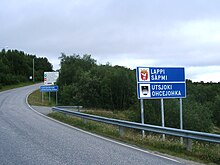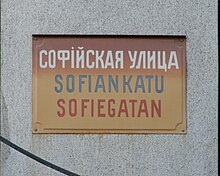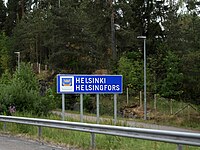| Languages of Finland | |
|---|---|
| Official | Finnish (1st: 86%, 2nd: 13%) Swedish (1st: 5%, 2nd: 44%) |
| Minority | officially recognized: Sami, Romani, Finnish Sign Language, Finland-Swedish Sign Language, Karelian |
| Immigrant | Estonian, Russian, Arabic, Somali, English, Kurdish, Albanian, Persian, Chinese, Vietnamese, Thai, Tagalog, Turkish, Spanish |
| Foreign | English (70%) German (30%) French (10%) |
| Signed | Finnish Sign Language, Finland-Swedish Sign Language |
| Keyboard layout | QWERTY Basic Finnish/Swedish  Finnish Multilingual  |
| Source | (europa.eu) |
The two main official languages of Finland are Finnish and Swedish. There are also several official minority languages: three variants of Sami, as well as Romani, Finnish Sign Language, Finland-Swedish Sign Language and Karelian.
Finnish

Finnish is the language of the majority, 85.7% of the population in 2022. It is a Finnic language closely related to Estonian and less closely to the Sami languages.
Swedish
Main articles: Finland Swedish and Åland SwedishSwedish is the main language of 5.2% of the population in 2022 (92.4% in the Åland autonomous province), down from 14% at the beginning of the 20th century. In 2012, 44% of Finnish citizens with another registered primary language than Swedish could hold a conversation in this language. Swedish was the language of the administration until the late 19th century. Today it is one of the two main official languages, with a position equal to Finnish in most legislation, though the working language in most governmental bodies is Finnish. Both Finnish and Swedish are compulsory subjects in school with an exception for children with a third language as their native language. A successfully completed language test is a prerequisite for governmental offices where a university degree is required.
The four largest Swedish-speaking communities in Finland, in absolute numbers, are those of Helsinki, Espoo, Porvoo and Vaasa, where they constitute significant minorities. In Helsinki, currently 5.5% of the population are native Swedish speakers and 18.3% are native speakers of languages other than Finnish and Swedish.
The Swedish dialects spoken in Finland mainland are known as Finland-Swedish. There is a rich Finland-Swedish literature, including authors such as Tove Jansson, Johan Ludvig Runeberg, Edith Södergran and Zacharias Topelius. Runeberg is considered Finland's national poet and wrote the national anthem, "Vårt land", which was only later translated to Finnish.
Within language policy making in Finland, Taxell's paradox refers to the notion that monolingual solutions are essential to the realization of functional bilingualism, with multilingual solutions ultimately leading to monolingualism. The thinking is based on the observation of the Swedish language in environments such as schools is subordinated to the majority language Finnish for practical and social reasons, despite the positive characteristics associated with mutual language learning.
English
English is spoken as a foreign language by most Finns. Official statistics from 2012 show that at least 70% of Finns can speak English. English is the native language of 0.5% of the Finnish population.
Sami languages

The Sami languages are a group of related languages spoken across Sápmi. They are distantly related to Finnish. The three Sami languages spoken in Finland, Northern Sami, Inari Sami and Skolt Sami, have a combined native speaker population of only 2,035 in 2022 albeit there are more than 10,000 Sami people in Finland. The state of Finland has a history of aiming to assimilate the indigenous Sámi people to the Finnish-speaking majority.
Romani
The Romani language in Finland is called Finnish Kalo. It has been spoken in Finland for roughly 450 years. It has been significantly influenced by other languages in Finland, such as Finnish. Of the around 13,000 Finnish Romani, only 30% speak and understand the language well. The number of speakers diminished drastically after WW2. Most Finnish Romani speak Finnish or Swedish in their day-to-day life.
Finnish municipalities have the possibility to organize education in Finnish Kalo, if there are a sufficient amount of Romani children to form a group. A significant challenge to this is the lack of Finnish Kalo teachers. According to the Finnish constitution, Finnish Romani have the right to practise their language and culture. The number of Romani language speakers is estimated to have decreased by 40% over the past 50 years.
Karelian
Until World War II, Karelian was spoken in the historical Border-Karelia region (Raja-Karjala) on the northeastern shore of Lake Ladoga. After the war, evacuated Karelian speakers were settled all over Finland. In 2001, the Karelian Language Society estimated that the language was understood by 11,000–12,000 people in Finland, most of whom were elderly. A more recent estimate is that there are around 5,000 first language speakers in Finland, but the size of the language community is 30,000.
Karelian was recognized in a regulation by the then president Tarja Halonen in November 2009, in accordance with the European Charter for Regional or Minority Languages.
Russian

The Russian language is the most spoken immigrant language in Finland (1.7%). Nonetheless, the Russian language still has no official minority status in Finland, although historically it served as a third co-official language with Finnish and Swedish between 1900 and 1917.
Sign languages
In Finland, two sign languages have official status, the Finnish Sign Language and the Finland-Swedish Sign language, both of which belong to the Swedish Sign Language family.
Finnish Sign Language is the sign language most commonly used in Finland. There are 5,000 Finnish deaf who have Finnish Sign Language as a first language. As the Finnish system records users by their written language, not their spoken alone, nearly all deaf people who sign are assigned this way and may be subsumed into the overall Finnish language figures. However, Finland-Swedish sign is today only spoken by around 300 people, and is severely endangered.
Territorial bilingualism

All municipalities outside Åland where both official languages are spoken by either at least 8% of the population or at least 3,000 people are considered bilingual. Swedish reaches these criteria in 59 out of 336 municipalities located in Åland (where this does not matter) and the coastal areas of Ostrobothnia region, Southwest Finland (especially in Åboland outside Turku) and Uusimaa. Outside these areas there are some towns with significant Swedish-speaking minorities not reaching the criteria. Thus the inland is officially unilingually Finnish-speaking. Finnish reaches the criteria everywhere but in Åland and in three municipalities in the Ostrobothnia region, which is also the only region on the Finnish mainland with a Swedish-speaking majority (52% to 46%).
The Sami languages have an official status in the northernmost Finland, in Utsjoki, Inari, Enontekiö and part of Sodankylä, regardless of proportion of speakers.
In the bilingual municipalities signs are in both languages, important documents are translated and authorities have to be able to serve in both languages. Authorities of the central administration have to serve the public in both official languages, regardless of location, and in Sami in certain circumstances.
Places often have different names in Finnish and in Swedish, both names being equally official as name of the town. For a list, see Names of places in Finland in Finnish and in Swedish.
Statistics
Population by mother tongue (2023)
Finnish (84.89%) Swedish (5.10%) Russian (1.78%) Estonian (0.90%) Arabic (0.74%) English (0.60%) Somali (0.46%) Other (5.53%)

93% of Finns aged 18–64 can speak a foreign language, and 78% can speak two or more. 2,184,000 or 66% can speak both Swedish and English, while 1,003,000 (30%) can speak German and English and 882,000 (27%) Swedish and German.
| Language | Speakers | Percentage of total population (2021) | |
|---|---|---|---|
| (2011) | (2021) | ||
| Finnish | 4,863,351 | 4,800,243 | 86.52% |
| Swedish | 291,219 | 287,933 | 5.19% |
| Russian | 58,331 | 87,552 | 1.58% |
| Estonian | 33,076 | 50,232 | 0.91% |
| Arabic | 11,252 | 36,466 | 0.66% |
| English | 13,804 | 25,638 | 0.46% |
| Somali | 14,045 | 23,656 | 0.43% |
| Persian | 5,623 | 16,499 | 0.30% |
| Kurdish | 8,623 | 15,850 | 0.29% |
| Chinese | 8,257 | 14,780 | 0.27% |
| Albanian | 7,408 | 13,830 | 0.25% |
| Vietnamese | 6,060 | 12,310 | 0.22% |
| Thai | 6,342 | 10,831 | 0.20% |
| Turkish | 5,720 | 10,039 | 0.18% |
| Spanish | 4,988 | 9,891 | 0.18% |
| Ukrainian | 1,500 | 7,278 | 0.13% |
| German | 5,592 | 7,258 | 0.13% |
| Romanian | 2,018 | 6,326 | 0.11% |
| Polish | 3,139 | 5,982 | 0.11% |
| Tagalog | 1,638 | 5,934 | 0.11% |
| French | 3,152 | 5,352 | 0.10% |
| Bengali | 2,007 | 5,131 | 0.09% |
| Nepali | 1,475 | 5,048 | 0.09% |
| Serbo-Croatian | 3,676 | 4,958 | 0.09% |
| Urdu | 1,432 | 4,163 | 0.08% |
| Portuguese | 1,785 | 3,837 | 0.07% |
| Italian | 1,806 | 3,356 | 0.06% |
| Bulgarian | 1,377 | 3,264 | 0.06% |
| Hindi | 1,360 | 3,245 | 0.06% |
| Hungarian | 2,181 | 3,243 | 0.06% |
| Latvian | 966 | 3,023 | 0.05% |
| Swahili | 998 | 2,675 | 0.05% |
| Tamil | 1,080 | 2,409 | 0.04% |
| Dutch | 1,281 | 2,029 | 0.04% |
| Sami | 1,870 | 2,023 | 0.04% |
| Greek | 792 | 1,866 | 0.03% |
| Tigrinya | 239 | 1,842 | 0.03% |
| Lithuanian | 796 | 1,796 | 0.03% |
| Japanese | 1,152 | 1,738 | 0.03% |
| Amharic | 1,046 | 1,718 | 0.03% |
| Pashto | 613 | 1,527 | 0.03% |
| Kinyarwanda | 456 | 1,308 | 0.02% |
| Uzbek | 120 | 1,269 | 0.02% |
| Telugu | 703 | 1,242 | 0.02% |
| Punjabi | 770 | 1,240 | 0.02% |
| Yoruba | 499 | 1,145 | 0.02% |
| Igbo | 437 | 1,046 | 0.02% |
| Family | No. of speakers | Percentage |
|---|---|---|
| Finno-Ugric | 4,877,161 | 88.27% |
| Germanic | 320,016 | 5.79% |
| Slavic | 102,161 | 1.85% |
| Afroasiatic | 57,844 | 1.05% |
| Indo-Iranian | 47,804 | 0.87% |
| Romance | 24,802 | 0.45% |
| Sino-Tibetan | 13,760 | 0.25% |
| Turkic | 11,651 | 0.21% |
| Austroasiatic | 11,459 | 0.21% |
| Tai | 10,243 | 0.19% |
| Niger-Congo | 8,841 | 0.16% |
| Austronesian | 5,678 | 0.10% |
| Dravidian | 4,036 | 0.07% |
| Baltic | 3,884 | 0.07% |
| Greek, Latin | 1,716 | 0.03% |
| Japonic | 1,617 | 0.03% |
| Caucasian | 932 | 0.02% |
| Other Indo-European | 12,141 | 0.22% |
| Other Asian | 958 | 0.02% |
| Other | 8,588 | 0.16% |
| Language | Percentage |
|---|---|
| English | 90% |
| Swedish | 67% |
| German | 31% |
| French | 11% |
| Finnish | 10% |
| Spanish | 10% |
| Russian | 8% |
See also
- Finland's language strife
- Languages of Åland
- Names of places in Finland in Finnish and in Swedish
- Languages of Sweden
- Languages of Norway
- Languages of Denmark
- Languages of Greenland
References
- La langue française dans le monde 2014 (PDF) (in French). Nathan. 2014. pp. 13–19. ISBN 978-2-09-882654-0. Archived from the original (PDF) on 12 April 2015. Retrieved 5 April 2015.
- "De finlandssvenska teckenspråkiga – en osynlig minoritet". svenska.yle.fi (in Swedish). Retrieved 2024-05-06.
- ^ "Number of foreign-language speakers grew by nearly 38,000 persons". Statistics Finland. 2022. Retrieved 12 September 2023.
- Europeans and their languages, situationen 2012 Archived 2016-01-06 at the Wayback Machine, p. 21
- Valkonen, Eero (2020). "En- eller tvåspråkiga lösningar? : diskursanalys om användning av begreppet "den taxellska paradoxen" i Vasabladets debattinlägg 2013–2018". University of Jyväskylä (in Swedish).
- "Taxell om sin paradox". svenska.yle.fi (in Swedish). Retrieved 2022-05-17.
- "Europeans and their languages". Special Eurobarometer 386. June 2012. p. 21. Retrieved 27 August 2021.
- "Tietoa meistä". Saamelaiskäräjät (in Finnish). Retrieved 2024-02-13.
- "Romanikieli on vaarassa kadota" (in Finnish). YLE. Retrieved 2 December 2022.
- "Muut kielet" (in Finnish). Ministry of Justice. Retrieved 2 December 2022.
- "Etusivu Kielitieto Kielet Karjala".
- Change in the regulation by the president of Finland about European Charter for Regional or Minority Languages, 68/2009 27.11.2009 (in Finnish)
- ^ "Suomen viittomakielet". Kotimaisten kielten keskus (in Finnish). Retrieved 2024-05-12.
- "De finlandssvenska teckenspråkiga – en osynlig minoritet". svenska.yle.fi (in Swedish). Retrieved 2024-04-29.
- "Language according to age and sex by region, 1990-2023". stat.fi. Retrieved 25 May 2024.
- "Eurobarometer". europa.eu. Retrieved 2021-06-20.
- "Tilastokeskus - 3. Useampaa kuin yhtä vierasta kieltä osaa 78 prosenttia suomalaisista".
- "Befolkning 31.12. efter Område, Språk, Kön, År och Uppgifter". Tilastokeskuksen PX-Web tietokannat (in Swedish). Retrieved 2021-06-20.
- "Väestö 31.12. muuttujina Maakunta, Kieli, Ikä, Sukupuoli, Vuosi ja Tiedot". Tilastokeskuksen PX-Web tietokannat (in Finnish). Retrieved 2021-06-20.
- "Englantia, ruotsia ja saksaa osataan eniten" (in Finnish). Statistics Finland. Retrieved 2 December 2022.
- ^ As a second language.
External links
[REDACTED] Media related to Languages of Finland at Wikimedia Commons
| Languages of Finland | |||||
|---|---|---|---|---|---|
| Official languages | |||||
| Minority languages |
| ||||
| Sign languages | |||||
| Related | |||||
| Finland articles | |||||
|---|---|---|---|---|---|
| History | |||||
| Geography | |||||
| Politics | |||||
| Economy | |||||
| Society |
| ||||
| Languages of Europe | |
|---|---|
| Sovereign states |
|
| States with limited recognition | |
| Dependencies and other entities | |
| Other entities | |
| Minority languages of Europe | |
|---|---|
| European Union | |
| Other European states | |
| States with limited recognition | |
| Dependencies and other territories | |